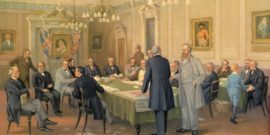We, however, are determined to learn whether responsible and disciplined—in a word, constitutional—government can survive the death of civic piety.
Originalism and Religious LIberty
The first day of teaching undergraduate constitutional law, I (not a lawyer) would take a well-regarded law school casebook, and I would ask a student to find the Dred Scott case in it. It was only referred to. Law schools have practical purposes, so why teach a case that is (mistakenly) regarded as completely irrelevant to contemporary law? Yet, unless one knows what the Reconstruction Amendments were presumably repudiating, how can one know what they stand for?
When done well, the study of the law strives to articulate a realm where the passions would be conquered and only the logic of the law would rule. High purposes like this informed Tocqueville’s nomination of lawyers as the American aristocracy. The originalist understanding of law would tame democratic majoritarian passions as well as anti-democratic ones. Whether this vital enterprise can be accomplished without recourse to the Declaration of Independence and other founding documents (link no longer available) is highly problematic.
Vincent Philip Munoz’s casebook, Religious Liberty and the American Supreme Court (Rowman and Littlefield, 2013) offers a way for professors (including those who teach undergraduate political science and law courses) to teach the law in accord with true originalism. At just over 600 large-type pages of cases and documents, the book’s distinctiveness is its chronological ordering.
Tracing the fate of religious liberty requires we develop the categories such as “Free Exercise Clause: Direct Burdens,” Indirect Burdens, Free Exercise/Free Speech Clause, Establishment Clause in the Public Square, government and religious schools, and public schools. Skillful editing and selection of cases reinforce our impression that a founding consensus was lost, dissolved into bizarre sideways such as the Lemon test.
His first book, God and the Founders: Madison, Washington, and Jefferson noted the founders’ disparate views on religion. His scholarship serves, among other purposes, the practical need for contemporary partisanship to pay heed to the diverse views of religion in our founding.
One would of course wish with Munoz that he might have added more documents to his deftly assembled 23-page compilation. Washington’s Thanksgiving proclamation, Lincoln’s Second Inaugural, and the Blaine Acts might have been included. But a personal favorite for inclusion would be the ending of Washington Irving’s Legend of Sleepy Hollow.
We all recall from childhood the hilarity of poor Ichabod’s terror at his nocturnal pursuit by a headless rider, but in our maturity we need to study the aftermath. In one account, we hear that the headless horseman victim, having fled Sleepy Hollow after his frightening encounter, “had kept school and studied law at the same time, had been admitted to the bar, turned politician, electioneered, written for the newspapers, and finally had been made a justice of the Ten Pound Court.” The credulous fool, fleeing his disgrace (as have other, more recent New York politicians), had sought redemption in politics, having become a lawyer, a journalist, politician, and finally a judge! Crane seems a model for the judicial activist judge—a combination of his earlier arrogance and obsequiousness, fueled by superstition..
In deriding Crane’s religious sentiment, did Irving, with Hobbesian humor, underrate its importance for democratic life? Did Dutch Calvinism require considerable reform before it could be made safe for democracy? Did Crane become a proto-Holmesian? He stands as a version of the theologico-political question that remains at the center of political life.
Yet, despite Munoz’s omission of the Irving story from his small list of documents, they are certainly well-chosen, as are his cases (especially those obscure, early ones he reminds us of). His work is not only a worthy addition to the teaching of religious liberty but to future compilers of casebooks who might duplicate his originalist approach.

